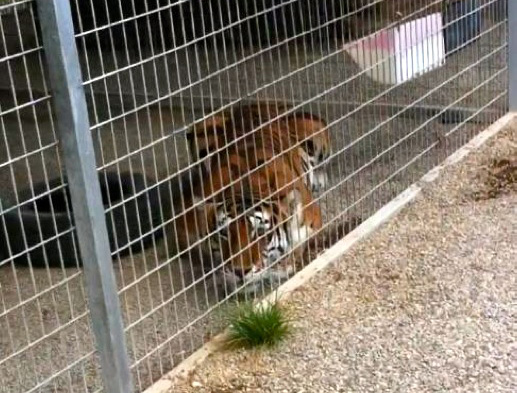Up until the 1960s breeding exotic cats was
primarily done by zoos and a small number of breeders
focused on preserving the species. In 1972 Siegfried and Roy
began their tiger act in Las Vegas. It ran for almost 6,000
performances, ending in 2003 when one of Roys tigers bit him
in the neck. In the span of 30 years their act popularized the
notion that tigers could be trained and that white tigers were
a rare and special breed. Along with other tiger acts and
tigers appearing on television variety and talk shows, tigers
used in advertising and as celebrity ornaments, the idea of
exotic pet ownership took hold with people believing you could
buy and care for these cats and they would become your
household pets.
As popularity and demand increased, the supply
in the form of backyard breeders multiplied as they became
Breeding Farms.
The public story presented by many breeders
often conceals a cruel and avaricious reality.
Tigers are bred without any consideration for animal husbandry or genetic diversity. What is important to
breeders is the number of cubs and the color combinations that
might be realized. There are breeders who advertise new
'American' tiger species: golden tabbies and other stripe
color variations. And then there are the liger, tigon and
other strange and completely unnatural pairings. While they
advertise conservation education and 'saving the gene pool',
in reality it is all about the money: an exotic color or unusual
appearance means cash to the breeders and exhibitors.
Some breeders
believe continued inbreeding will produce a cub that is pure white (no color and no stripes)
that will be worth $100,000. The cubs who survive but don't meet the goals
of these breeders, the ones who are the wrong color or have
obvious birth defects, are sold cheaply,
given away, or destroyed.
White tigers mean big money.
These tiger mills breed generic tigers that are
used for pay-to-play sessions where the public pays to pet or
pose with a baby tiger. Once the cubs are too old to use they
are discarded into the pet trade, warehoused in tiny, barren
cells, or may disappear into the black market for tiger parts.
In the wild, a mother tiger breeds about every
three years. It takes that long to raise and train her litter
of cubs. Breeders take the baby tigers away from their
mothers when they are two days old; the mothers are bred again
as many as 3 times each year. This takes a huge toll on
breeding females and the cubs who rely on them. Tigers are
genetically geared to be the most protective mothers in the
world. After ten years of breeding 20 to 30 litters, and
giving birth to over 100 cubs, the mother tiger is discarded
and usually dies of breast cancer, and the cubs are totally
dependent on humans.

Grieving mother tiger in Oklahoma, cubs
taken at 2 days old.
Breeders advertise in print and online.
The $30,000 ad below is from the June 2011 issue of Animal
Finders Guide.


